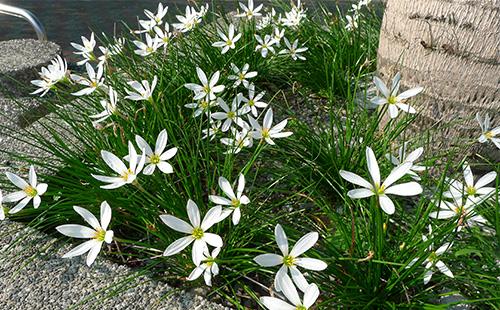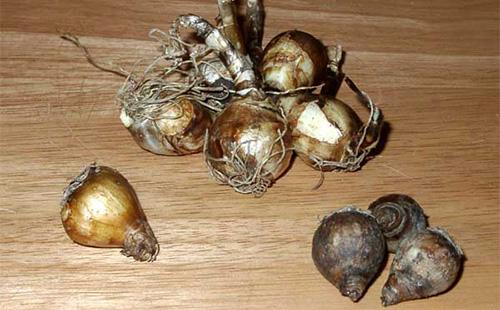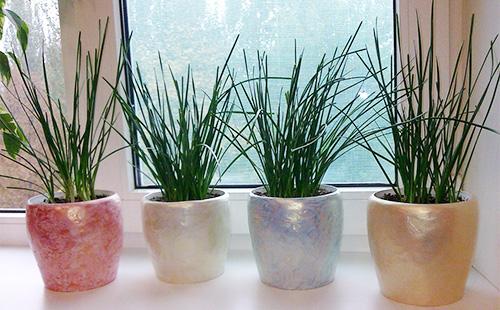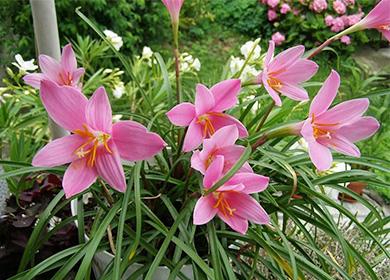The content of the article
Rain Lily, Fairy Lily - these are exactly the names that he was given by lovers of room exotic. The name “zephyranthes” was formed from the confluence of two Greek words: “zephyr” is translated as “west wind” and “anthos” is a flower. The features that are endowed with the "flower of the west wind" secured a less romantic name for it - the upstart.
Botanical characteristic
The plant is a perennial, flowering, bulbous. Comes from the Amaryllis family. It has narrow, grassy leaves of dark green color up to 40 cm in length. The flower stalk is hollow, tubular, the height does not exceed 30 cm. The bulbs have a rounded shape, more rarely oblong, the diameter does not exceed 3 cm. Flowering begins in April and, with proper care, can last until the end of summer:
- the flowers - single, wide open;
- the petals - pointed;
- core- studded with bright yellow anthers.
Flower species
According to various sources, from 40 to 100 types of marshmallows are found in nature. On the windowsills give a color of no more than 10-12. The most popular, according to reviews, are the white-flowered fairies lilies.
- Zephyranthes snow-white. It blooms in July and October, it feels comfortable in cool rooms with enough light. The petals are white inside, but have a slightly pinkish tint from the outside. Having a pointed shape, they reach 6 cm in length. Bulbs of medium size with an elongated neck.
- Zephyranthes Atamas. It blooms in March and April. Feels comfortable at low temperatures. Petals are lanceolate. The bulbs are small, elongated, the neck is slightly shortened.
- Zephyranthes is golden. It blooms in December and January. In the southern regions, he feels comfortable in garden beds. Has a cup of flower, bright yellow, pointed to the bottom. Bulbs - medium size, rounded.
- Zephyranthes pink (large-flowered). It blooms in April-May. The flowers are large, painted in pink shades. Bulbs of elongated shape, the neck is slightly shortened.
- Zephyranthes multicolored. Flowering begins in mid-winter and continues in the spring months. It easily takes root in a room where the air temperature does not exceed 20ºС. The flowers have a red tint with greenish veins on the outside and completely white inside. Bulbs are oblong, covered with a dark film.

Zephyranthes: care and what conditions need to be created
In a warm climate, a rain lily easily takes root in the open ground and serves as a decoration for a flower bed for several months. But the practice of growing plants in pots is still more popular. The flowering time of the plant largely depends on how to care for the marshmallows.
- Temperature. Compliance with the temperature regime during the growing season and dormancy does not allow the bulbs to rot. For growth and development, the temperature from 18 to 25ºC is considered optimal. For relaxation, the plant needs lower temperatures - from 10 to 12 ºC. Ventilating the premises or landing in open areas will create favorable conditions for active life.
- Lighting. Need bright light, which provides abundant flowering and enlargement of bulbs. Direct sunlight is permissible; it does not adversely affect delicate fragile leaves. The rules for growing zephyranthes (upstart flower) at home allow the plant to be placed on the windowsills of any windows, with the exception of the north side. In summer, the pots are displayed on the balcony in the garden.
- Watering. The bulbs of the upstart are rotten and therefore demanding watering. Humidification of the soil is performed as the top layer dries up, and used water is used. Liquid stagnation and complete drying of an earthen coma is unacceptable. In rooms with low humidity carry out regular spraying of leaves. When the active phase of flowering is stopped and the plant goes into a dormant state, watering must be reduced.
- Top dressing. An actively developing plant must be watered with liquid mineral stimulants at least once a week. Fertilizer contributes to the preservation of rich tones and flowering time.
Transplant Features
Transplant a flower upstart immediately after waking up. An ideal dwelling is a shallow flowerpot, in which several bulbs are planted simultaneously. It should be remembered that the root necks should not be deepened into the soil, but towered a few millimeters above it. The soil composition must contain the required three components in equal proportions:
- turf land;
- humus;
- sand.
It is also necessary to take care of providing drainage.

Increase in numbers
Reproduction of Zephyranthes (upstart flower) is carried out both by seeds and newly formed bulbs. Planting and growing seeds is a time-consuming process, they rarely resort to its help. The seedling will bloom no earlier than in a few years, while the onions will bloom next year.
The vagaries of lilies fairies
Like all the inhabitants of the flower beds on the windowsills, the fairies lily requires attention to their person. She expresses dissatisfaction with the quality of care in her own way.
- The tips of the leaves are dry. Very often, gardeners amateurs encounter problems, as a result of which the leaves turn yellow and dry. This indicates violations of the irrigation conditions, which led to the decay of the root system. The plant can be cured by removing infected parts of the plant, treating it with fungicide and planting it in renewed soil.
- No flowers appear. The reason for which the zephyranthes does not bloom, must be sought in an improperly selected container. A deep pot contributes to the active build-up of the root system, directing all forces into a given channel. The smaller and wider the flowerpot, the more flowering will be.

Diseases and Pests
Diseases, as a rule, bypass the upstart. Only improper watering can adversely affect the condition of the bulbs. It is extremely rare that a plant is attacked by fusarium (red rot). The disease is caused by a fungus that infects the bulb through small wounds and fissures.The sick link must be separated with a lump of earth and prevent spread. Healthy onions must be treated with Maxim or a weak potassium permanganate solution.
Pests infect the flower not often, but quite actively. Among the main enemies of the upstart are the following:
- Amaryllis earthworms;
- spider mites;
- scale insects;
- whitefly.
The following table will tell you how to recognize and fix the problem.
Table - Insects that damage marshmallows, and how to deal with them
| The name of the pest | Appearance, features | Diagnostics | Ways to fight |
|---|---|---|---|
| Amaryllis Worms | - Small; - transparent white color; - eat onion pulp | - Yellowing, wilting, falling leaves; - stunting | - Remove badly damaged bulbs; - treat the remaining insecticides; - observe watering rules (do not overfill) |
| Spider mites | - Small; - appear in conditions of low humidity and dry air; - able to lead to drying out, death of the plant | - The appearance of cobwebs on leaves and stems | - Wash affected areas with soap and water; - rinse the leaves and stems with warm water; - in case of abundant infection, conduct treatment with the “Anticlesch” insecticide |
| Shields | - Small; - eat plant juice; - have a characteristic shield on the back, which allows to resist the effects of insecticides | - Small brown plaques appear on leaves and stems; - leaves, bud stems dry out, lose their color | - Wipe all affected areas with a cotton swab dipped in Aktellik solution (Aktara, Karbofos, Decis); - process the windowsill, the outer part of the pot; - inspect in a few days and, if necessary, repeat the processing procedure |
| Whitefly | - Small, similar to moths; - live on the bottom of leaves and shoots; - greenish larvae feed on juice from leaves, leaving waste products on the surface | - Leaves turn yellow, fall off; - if you shake the pot, a swarm of insects will rise into the air | - Reduce the frequency of watering; - feed the soil with fertilizers; - transfer the pot to a well-ventilated place; - treat with permethrin-containing preparations ("Actellic") |
How to care for Zephyranthes in a pot, you will fully understand only when faced with a number of its features. Indoor lily will delight with its flowering in winter and summer, subject to simple instructions. Sun, air and water are the three main components of the successful flowering of Zyphyranthes.
Reviews: “Why upstart? You don’t expect flowers, but they, bam, have blossomed! ”
I have been growing this flower for about 10 years. He amazes me with his unpretentiousness and endurance. I call him indoor daffodil. Bulbous plant. I rarely transplant it once every 3-5 years, when there is already little space for bulbs in the pot. I tried to grow on the site. It bloomed all summer, but left for the winter in the land did not survive. But I dug up the bulbs dug in the fall and they lay with me in paper in the pantry for more than six months. When I found them, half dried up, but there were still those that I planted and they went to grow. Plant care is minimal, watering as the soil dries up and take a shower 1-2 times a month. I did not notice pests and diseases on it. The height of the plant is about 30 cm.
We often leave in the summer for several weeks, and there is always a problem how to preserve indoor plants, and I never worry about these. I watered before leaving and forgot. Of course, upon arrival, my flower is half dry. I clean it, water it and again my flower continues to grow. And he survives thanks to the accumulated nutrients in the bulb.Elrol, http://otzyv.expert/takoy-neprihotliviy-i-zhivuchiy-2110042
This indoor flower was presented to me by my friend ten years ago, just a few bulbs. I did not imagine that in a year, I would already have a flower resembling a bouquet of beautiful snow-white crocuses. This plant is called flower growers as a domestic daffodil, a water lily for its snow-white flowers.The plant did not require special care, just watering.
Since there was not enough space on the windowsill, I moved the flower to the top shelf in the children's room, but this did not affect the growth of this flower, it did not cease to please its flowering for a long time. Welcoming this behavior of the flower, I planted its bulbs, which further influenced the magnificent growth and abundant flowering. I have never met such flowers so that with a minimum of care such growth and continuous flowering.
Every year, planting bulbs, and the number of flowers of this plant increased. I also planted this plant in a summer cottage. Such free conditions for the growth of bulbs further contributed to plentiful long-term flowering.Tamarav, http://spasibovsem.ru/responses/domashnij-nartsiss.html
At first, the zephyranthes did not cause me any emotions - I grew up looking like a rather rare grass in a pot on a working windowsill. But as soon as the plant bloomed, it fascinated me!
The people call this indoor bulb flower "upstart". This is due to the fact that completely unexpectedly and suddenly among the foliage a peduncle appears, which simply grows before our eyes! Literally just one day a flower needs to fully grow the peduncle! Amazing!
Zephyranthes flowers are insanely delicate in color and in appearance - like stars. Flowers can be painted in white, yellow or pale pink. There are a lot of flowers at the same time, therefore a sensation of a blooming meadow is created: as if sweet flowers suddenly grew among the grass.
The nature of the upstart is manifested in this plant so that you never expect flowers, but - bam! - they have already blossomed)) A very unpredictable plant, and therefore interesting. In addition, it is completely undemanding in leaving: he needs a lot of light, the temperature will suit the average room temperature. The soil should only always be kept moist, but not flooded, otherwise the onions will rot. That's all the care!Murmur, http://spasibovsem.ru/responses/byt-vyskochkoj-vovse-i-ne-ploho.html

